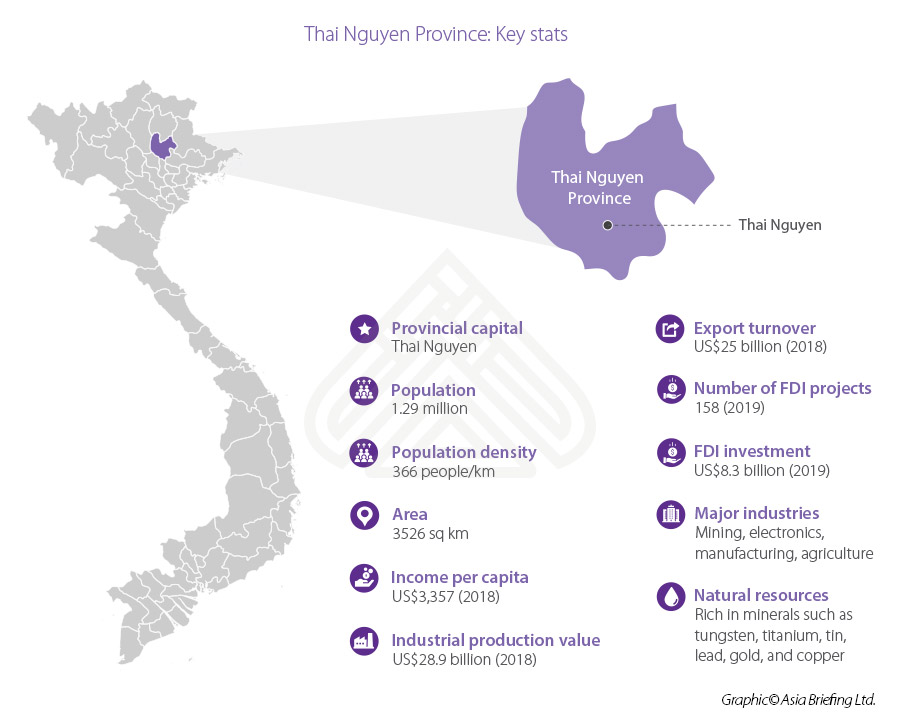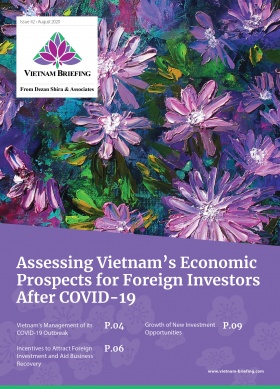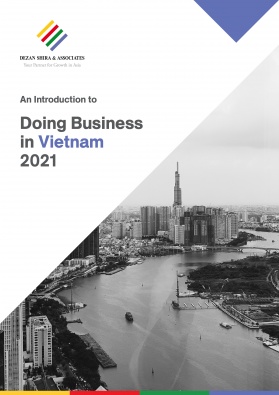Vietnam’s Thai Nguyen Province – Investment Guide for Investors
- Vietnam’s northern Thai Nguyen province has evolved into a leading investment hub for foreign investment.
- The province is known for its well-equipped infrastructure, business-friendly environment, and adequate industrial zones.
- Thai Nguyen ranked 12th overall in Vietnam’s Provincial Competitive Index 2019 and fourth-best in the PCI’s infrastructure category.
Over the past decade, Vietnam’s northern province of Thai Nguyen has evolved into a leading magnet for attracting foreign direct investment, thanks to its investor-friendly business environment, transparent policies, and strategic location. Provincial authorities have leveraged these advantages for fostering the development of its industrial infrastructure.
In 2018, Thai Nguyen had the second-highest number of businesses among the country’s 14 north-central and mountainous provinces.
Vietnam Briefing looks a the investment climate of Thai Nguyen and factors that make it competitive for investors.
Administrative reforms and digital transformation
Thai Nguyen’s ranking in UNDP’s Public Administration Reform (PAR) Index rose 40 places in the three years preceding 2020, placing it among the top 15 provinces in terms of administration. This significant improvement resulted from the province’s extensive administrative reforms in the past decade. Such efforts have resulted in an open, transparent, and favorable business environment. Thai Nguyen strives to be among Vietnam’s top 10 localities on the PAR index.
The province is driving the digital transformation of northern Vietnam towards e-governance. In 2020, Thai Nguyen brought close to 40 percent of its administrative procedures online, an 11-fold rise in the past decade. Recently, the province signed an MoU with Viettel Industry to implement an e-governance model by 2025. The MoU encompasses the following broad goals:
- Construction of intelligent operations support center for the Provincial People’s Committee;
- Building smart health and education systems; and
- Streamlining administrative sector with digital transformation.
Thai Nguyen aims to lead the digital transformation of Vietnam’s North-Central and mountainous region. The vision of provincial authorities includes prioritizing digitization across several areas, including healthcare, education, agriculture, tourism, and public services.
Infrastructure centered around industry
In the past, the provincial capital, Thai Nguyen city, was a center for heavy-industry focused on steel and iron. However, the manufacturing sector is slowly shifting towards clean and high technology industries. The province is an essential industrial destination for South Korean enterprises in Vietnam.
Several new industrial zones have been upcoming in the districts adjacent to Thai Nguyen city. As per the 2019 Provincial Competitive Index (PCI) report, Thai Nguyen has Vietnam’s fourth most competitive infrastructure. Thai Nguyen’s proximity to Vietnam’s capital Hanoi (80km) and its excellent transport network make it an attractive destination for investors. The Hanoi – Thai Nguyen expressway, inaugurated in 2014, has reduced travel time between Hanoi and Thai Nguyen from three hours to one hour.
Provincial authorities are also keen on developing sustainable infrastructure that integrates industrial development with residential and recreational services. This concept aims to create an ideal living and working environment, reducing commute time by providing all facilities in one location. The Apec Diem Thuy Industrial Park is the most recent example of this model.
Economic profile
Thai Nguyen’s export experienced a ten-fold increase to over US$23 billion in the 2013 – 2017 period. The province hosted nearly 7,200 businesses in 2020 with a combined capital value approaching US$4 billion.
As per Thai Nguyen’s Department of Industry and Trade, for the first three quarters of 2020, the province’s total industrial gross output exceeded US$25 billion, while the domestic economic sector achieved US$1.8 billion. Both of these were over 70 percent of the province’s annual target. In the same period, foreign-invested enterprises generated close to US$23 billion, an increase of 2.3 percent over the previous year.
Among the province’s industries, the electronics and high-tech domains delivered the best results. Their production increased by over 16 percent year-on-year for laptops, while earphone manufacturing grew by five percent.
The socioeconomics of Thai Nguyen has seen remarkable development. In the first three quarters of 2020, industry and construction covered nearly 60 percent of the province’s economy while the services sector accounted for roughly one-third of the economy. In the same period, the province’s GDP per capita reached US$3,900, while industrial production rose by over 16 percent, and local exports grew by over 13 percent.
Thai Nguyen has also experienced significant development in infrastructure and labor productivity. Recently, the province experienced an influx of sustainable ventures. In 2020, over ten investment certificates were granted to eco-friendly and energy-efficient ventures, with a combined worth of over US$30 million.
Foreign investment landscape
Over the past decade, Thai Nguyen attracted a considerable amount of foreign direct investment. Samsung’s establishment of a mobile phone manufacturing complex in the province has dramatically boosted Thai Nguyen’s FDI. The province achieved over 13 percent compound annual growth rate (CAGR) during the 2015–2020 period.
As per the Foreign Investment Agency (FIA), in August 2020, the province hosted over 172 foreign-invested projects. Together these enterprises added over US$8 billion in registered capital. This made Thai Nguyen among the country’s top 10 localities in terms of international investment inflow.
In a bid to attract investors with industrial expertise, the province is concentrating on improving the local investment climate. Thai Nguyen has prioritized timely issuance of government policies, guidance, and support for financers. Local authorities have also shown a keen interest in high technology industries and ancillaries.
In December 2020, Hong Kong’s electronic firm, DBG Technology, was awarded an investment certificate by provincial authorities to set up a US$80 million manufacturing facility. This facility will manufacture laptops, cameras, phones, audio equipment, and home appliances. It is expected to generate a revenue of US$110 million annually, employing over 10,000 workers.
In the same month, China’s Trina Solar received Thai Nguyen’s approval to produce photovoltaic cells and solar power. With investment exceeding US$200 million, this facility has a planned capacity of over 250 million products a year. The plant is expected to begin operations from June 2021 and add over 1,800 jobs.
In November 2020, South Korean touchscreen manufacturer Samju Vina, injected capital to add a second plant in Thai Nguyen. This funding should raise its regional production per month from 20 million to 35 million units.
For enhancing its overall competitiveness, Thai Nguyen is actively encouraging the private and high-tech sectors to develop production clusters and connect value chains.
Factors that make Thai Nguyen competitive
Industrial zones
Thai Nguyen’s six industrial parks are spread over 1400 hectares of land area, five of which have already received funding. The province is promoting infrastructure investment in its 105-hectare Quyet Thang Hi-Tech Industrial Park that is situated eight kilometers away from Thai Nguyen city center.
The province’s plans include 35 industrial clusters with an area of nearly 1,260 hectares. The province has called for investment in 11 of these clusters, which have a planned area of over 280 hectares. The province aims to attract investment in secondary industries that complement the Samsung group and increase its localization degree.
Specifically, industries in electronics, electric, software, high precision mechanical, and textile are favored. The investment locations promoted by Thai Nguyen include the industrial zones in Yen Binh, Diem Thuy, and Song Cong. These, along with the province-wide industrial clusters, are equipped with appropriate technical infrastructure to establish enterprises.
To raise funds, Thai Nguyen provincial authorities encouraged investors to lease land for 50 years for a one lump sum payment. Consequently, these efforts led to the collection of US$65 million to develop industrial parks.
The Diem Thuy Industrial Park is one such example and features 77 projects with combined investment exceeding US$1.1 billion. This park’s projects are modern, eco-friendly, and employ over 20,000 locals.
China plus one location
Located in a favorable geographical area, Thai Nguyen is endowed with rich natural resources, proactive administration, and well-planned infrastructure. The province’s proximity to Hanoi and its vibrant ecosystem of large-scale industrial zones make it an attractive choice for manufacturers intending to leave or supplement their China operations, also known as China plus one strategy.
The province is also a member of the East-West Economic Corridor (EWEC), which connects Vietnam’s prominent seaports with China’s Guangdong and Guangxi provinces. These factors have helped raise the province’s industrial real estate market’s value.
Human resources
One of the key focus areas of Thai Nguyen’s administration is developing skilled and competent local human resources. It aims to leverage the province’s advantages and growth potential to fuel the development of its local universities and medical research centers towards Industry 4.0.
The province has seven universities and several vocational institutes that ensure an abundant and well-educated workforce.
Tea
Thai Nguyen produces tea, whose quality is world-renowned. But there is a need for its branding in the foreign markets to capitalize on its potential. Thai Nguyen is home to several tea-focused areas such as Dai Tu, Phu Luong, Dong Hy, and Thai Nguyen city.
The province aims to develop tea intensive zones in terms of tea processing, consumption, and ecological tourism. Thai Nguyen is prioritizing investments in the processing of high-quality tea.
Mining
With massive reserves of minerals such as titanium, tin, lead, gold, tungsten, and copper, Thai Nguyen has a strong potential to develop its mining and processing industry.
Vietnam’s Masan group has invested over US$430 million into Thai Nguyen in tungsten mining and processing. The group’s Nui Phao mine has the world’s second-largest tungsten reserves, employing 2000 workers and contributing significantly to the province’s economy.
Thai Nguyen’s efforts to attract investment
Thai Nguyen provincial authorities have taken a proactive approach towards attracting investment. These include shortening the time taken to complete administrative procedures by establishing a single-window-system.
The province has also implemented a one-stop-shop system, reducing the time for establishing business below two days and granting investment decisions within 25 days. The authorities have expedited the process of granting the land use rights certificate to under 24 days. By creating online portals for filing tax declarations and customs services, the province helps businesses save time from administrative procedures.
Thai Nguyen city recently upgraded its administrative facilities at the City People’s Committee’s headquarters. Implementing the one-stop-shop system has significantly improved the quality of processing administrative documents, achieving a timely-return-rate of over 99 percent.
Thai Nguyen’s outlook for the future
By 2030, provincial authorities aim to steer Thai Nguyen’s development towards becoming a sophisticated hub for the north-central and mountainous regions’ industry and economy. For this, the primary focus will be on making the province more conducive to business and investments.
By 2025, the province targets raising its GDP per capita to about US$6,500, a 66 percent raise over the 2020 value. To realize this goal, Thai Nguyen aims for an eight percent GDP growth. It is leaning towards an economic structure of industry and construction (61 percent), services (31 percent), and agro-forestry-fishery (8 percent).
Forecasts for this period indicate over a nine percent yearly growth in the Thai Nguyen’s industrial output, along with a 3.5 percent year-on-year increase in the value of agro-forestry-fishery production and a seven percent rise in local export value.
About Us
Vietnam Briefing is produced by Dezan Shira & Associates. The firm assists foreign investors throughout Asia from offices across the world, including in Hanoi and Ho Chi Minh City. Readers may write to vietnam@dezshira.com for more support on doing business in Vietnam.
- Previous Article Vietnam’s Southern Key Economic Region – A Magnet for Investment – Latest Issue of Vietnam Briefing Magazine
- Next Article Vietnam’s Thu Duc City: A New Innovation Hub for Ho Chi Minh City































